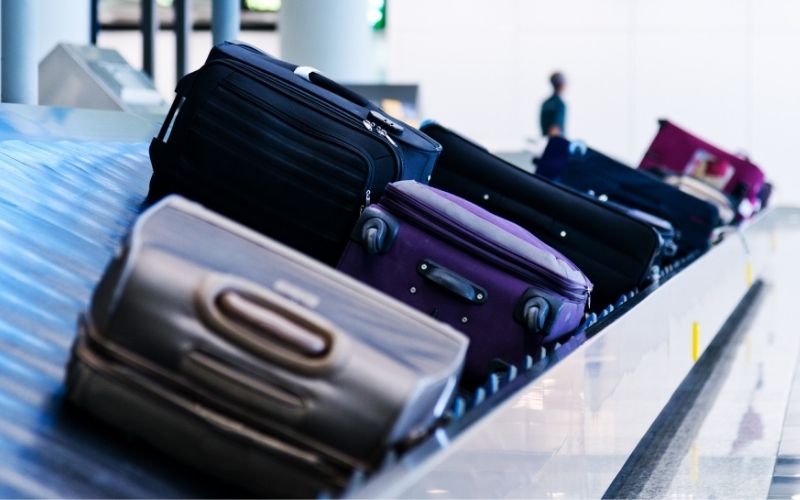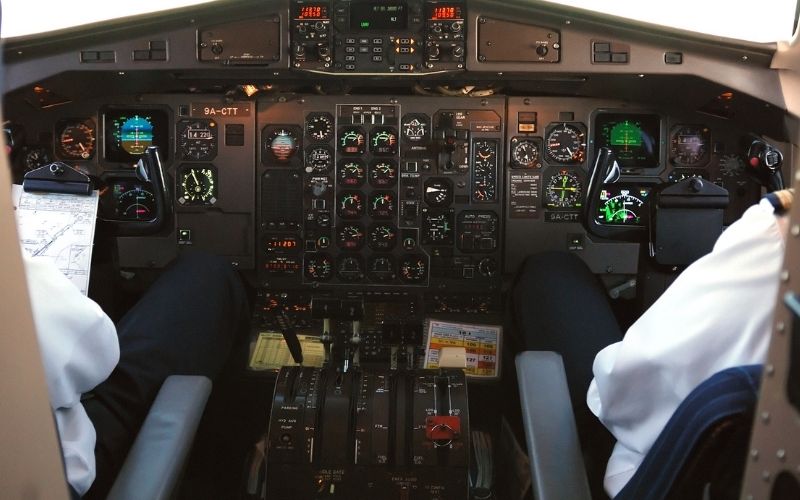Inside: If you’ve ever wondered if you can bring magnets on a plane, we’ve got everything you need to know right here.
Many of us who have traveled even a little have experienced a situation where you want to get a souvenir but lack the luggage space to accommodate any extra stuff.
Everything seems to come in a box or have way too much surface area for a package.
Then, like a spotlight from the universe, you see a whole collection of magnets.
For the most part, these decorated items for display are pretty flat and can easily slide into a zipped side pocket, hand baggage, or between layers of clothes. Much better than low-quality trinkets.

Can You Bring Magnets on a Plane? Magnets Aboard
Are any magnets allowed?
But with all the rules on what you can and can’t carry on airplanes, the next question may just be if magnets on a plane are a good idea or not. For the most part, yes, but there are exceptions.
So, let’s take a look at what the flying guidelines are.
According to the Transportation Security Administration, TSA, you can bring most magnets in both your carry-on and checked bags since they do not fall under the dangerous goods category.
That means if you see a super cute destination magnet in the gift shop before you board the plane, you don’t have to worry about having it on your person.
Be aware, however, that if the item seems questionable, the TSA officer has the final decision.
Is it safe to take magnets aboard a plane?
Typically, the magnets brought on planes are too small to make any dents in electronics.
Magnetic toys like magnetic chessboards or the ones mentioned as souvenirs fall into that category.
A small magnet of that size would have no real impact on anything happening in the plane or the tools used to navigate from one place to another.
Since that is an overwhelming majority of what comes through the airport, magnets are considered not dangerous.
Attracting A Hassle
Can you imagine how much longer the line would be during a luggage check if literally anything with a magnet on it had to be analyzed? Talk about frustration on all sides.
If a magnet had the potential to cause problems, it would be likely due to its strength or size.
The US Department of Transportation and the International Air Transport Association has set precise guidelines when a magnet would go beyond an acceptable level.
If they do exceed the agreed-upon certain thresholds, the magnet in question would be considered hazardous. At that point only specially trained staff would be able to handle the magnetized material.
Types of Magnets

Generally speaking, you should be fine carrying magnets in your bag. With that being said, there might be some types that could cause an extra inspection and perhaps a rejection.
Let’s go over various magnets to get more of an idea of what kind of problem they could cause if any.
1. Rare earth magnets
These have currently been deemed as possibly prohibited items because they are capable of having an impact on navigational equipment or other electronics needed to fly the plane.
In order for these magnets to fly, they have to be put in specially designed packaging. Examples of where they can be found are on hard drives, headphones, fishing poles, and cordless tools.
2. Neodymium magnets
These have a very strong magnetic pull and can cause bodily harm. These magnets can come together from several feet away.
Kind of like when Thor calls his hammer, Mjolnir, it will stop at nothing to get back to his hand. These magnets can break a finger if it’s in the way.
They also shatter pretty easily. Neodymium magnets can be found on devices such as smartphones, televisions, and filters.
3. Refrigerator magnets
Those small round magnets glued to the back of something interesting are the most common type of friendly magnet.
If you can put it on your fridge, it’s probably just fine to bring home on a plane. These are also found attached to kinds of magnetic toys
4. Industrial magnets
Magnets that go in heavy-duty places more often than not require handling by trained individuals.
This is because the magnetic field around them has the potential to adversely affect the electronics on the plane.
Examples of equipment with these magnets include motors, generators, pumps, plastic injection molds, and windmills.
Can magnets cause a problem with checked bags?

Whether a magnet is in your hands or in the cargo area, it can still make itself known. While the checked bag is all together, a strong magnet could cause issues down below.
The reason why points to what they are made to do, attract. Magnets aren’t just attracted to other magnets, they can also be compelled toward steel, iron, and other magnetic alloys.
Risky Magnet Business
Imagine bags sliding across the floor or wreaking havoc near the other bags. If a magnet strong enough was left for workers to handle, it could injure them just by handling a bag with that kind of magnet inside.
So, checked luggage that contains something of that strength or size could put everyone at risk. If not for the handling, the potential to mess with the system alone would be a downfall.
Airplane Navigation
Those of us who live in places around the world where smartphones are as commonplace as people are very lucky.
We are at the peak of technology and can do things like take a spur of the moment road trip 1,000 miles away or hop on a plane for the cheapest rate to take us across the ocean.
Many enjoy the freedom of things like the open road because we have navigation fresh at our fingertips.
As reliable as Google Maps is for getting us to our destination, airplanes have been using something even more trustworthy.
A magnetometer is used for navigation on a plane and air traffic control uses it in conjunction with the planes. It gives a measurement of the magnetic field.
Doing so enables the aircraft to only use the GPS as a backup.
What is a magnetometer?
A magnetometer is a tool that is used to measure magnetic fields and their field strength or direction. It can be used on earth and in space.
Miners use magnetometers to locate deposits of iron ore. Basically, there are different types of meters depending on what the need is.
Magnetometer Stands the Test of Time
Originally invented by Carl Friedrich Gauss in 1833, magnetometers underwent considerable advancements over the following 70-plus years. The later version is what stuck for navigation through today.
Magnets and Navigation

Magnets were used in navigation centuries before they were flying through the air across continents. As early as 206 B.C.E., the Chinese invented the magnetic compass.
A thousand years later, they were using the compass in the military and out at sea on their fleet of ships.
Magnets use the earth’s strong magnetic field to pinpoint direction. Magnetic poles are just a tad off-center from the planet’s rotation.
Between the axis and the geographic poles, the compass is able to provide the most reliable navigational directions.
That makes magnetometers more accurate than GPS, which is based on satellite navigation.
Why do magnets have an impact on airplane systems?
Planes use magnetometers in addition to GPS but focus their plans around the former due to their dependability.
Since they are the standard for getting you from point A to point B, it’s reasonable to expect that you would not want anything to interfere with that system.
That’s why some of the listed types of magnets above require extra precautions. The last thing you want to have problems within a plane would be the navigation or an error with vital electronics.
Magnets like neodymium or rare earth can alter what the magnetometer is telling the plane, which naturally would not be good.
If you don’t put your phone in airplane mode, will it cause problems?

Something else you may wonder about when flying is whether or not your cell phone is going to be problematic if you don’t place it in airplane mode.
The magnets are trouble with the magnetometer and the ability to not provide correct information. Cell phones do something different.
There’s a reason why airplane mode is a federal requirement. Unlike messing with magnets, cell phones can interfere with signals.
That’s because of the way cell phones communicate and get information.
Why are signals an issue?
They bounce from tower to tower looking for signals to get service. These strong signals being sent out while you’re zipping across state lines clash with cell towers on land.
Wi-Fi on a flight works with the plane’s network, not against it. Just like how you don’t want to take magnets on a plane, the next time you want to connect on a flight, get online instead.
What happens if an unauthorized magnet is in checked baggage?
Just because you didn’t physically walk your bags through a security checkpoint does not mean the luggage is not going through an even deeper scan somewhere else.
If you’re having doubts about the legitimacy of an item you plan to fly with, get in contact with TSA well in advance of leaving for the airport.
If a magnet of potential chaos is found in your checked luggage, it will be removed. At that point, it probably will be thrown away unless they can come up with a place that would take it as a donation.
What if I have a suspicious magnet in my carry-on bags?

Suspicious is probably one of the worst words you can use to describe something you bring to the airport.
It’s important to reassure you that everyday magnets should not pose a threat on your ability to board a plane properly.
That being said, if you have a questionable magnet, or anything else, it will be removed from your bag. At that point, you have a few choices on what you can do with it.
When A Problem Comes Along, You Must Ship It
If it turns out that you have an item that can’t go on the plane with you, the first thing the TSA agent will offer is to trash it. If that is unacceptable, they will return it to you.
Hopefully, you came in plenty of time because that means stepping out of line just to have to go through the line again later.
You then have the option of calling your ride back to get it from you or shipping it. Be advised, if the magnet is the problem, it might be an issue for the post, too.
Related:

